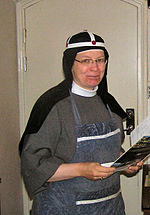Order of the Redeemer
The Order of the Redeemer , complete Order of the Most Holy Redeemer ( lat. Ordo sanctissimi Salvatoris ), abbreviation OSsS , OSSalv or OSBirg , also called Birgit Order after its founder , was originally a double order for nuns and monks . It was founded in 1346 by St. Birgitta (1303-1373). Birgitta of Sweden was made a co-patroness of Europe in 1999 by Pope John Paul II, together with Katharina von Siena and Edith Stein . The Order of the Redeemer now has 570 sisters worldwide.
The convents live according to the rule of St. Augustine and usually consist of nuns headed by an abbess . During the time of the double monasteries, the no more than 60 nuns were cared for by a community of ideally 13 religious priests - who corresponded to the number of Jesus Christ and his apostles. Deacons and lay brothers could also live in the monastery. However, the religious lived outside the enclosure . In their own large consulting room, the so-called collocutorium , which was shared by a cloister with a shop, men and women religious could talk to each other without looking at each other. For a long time, however, there have been separate monasteries for women religious and men of the Order of the Redeemer.
There are several branches of the Order of the Redeemer: From the old branch, which has existed since the Middle Ages, there are still three independent monasteries: the abbeys Pax Mariae in Vadstena , Maria Refugie in Uden and Maria Hart in Weert in the Netherlands. The convent of Syon Abbey in England was closed in 2012. In January 2017, the Altomünster monastery , in which at last only one professed and several female candidates lived, was closed.
In 1911, the Swedish convert Elisabeth Hesselblad founded a branch of the order in the tradition of the original order of the Savior, the motherhouse of which is located in Rome at the church of Santa Brigida . This is commonly called the “Swedish branch”. The Birgittenkloster Bremen is one of the more than 50 branches . The founder was beatified in April 2000 and canonized in 2016.
There is also a Spanish branch, the Birgitten von Valladolid (founded in 1630) and a fraternity in the United States (founded in 1976).
As a religious dress , the nuns wear a gray habit with a black veil, over which a linen crown made of three white linen strips with five red dots, which symbolize the five wounds of Christ, the brothers wear a gray or black habit with an emblem of the order on the scapular .
See also
Web links
- Tore Nyberg: Birgitten . In: Historical Lexicon of Bavaria
- Directory of Birgitten O.Ss.S. in German-speaking countries on medals online
- Special museum for the Birgitten order in Altomünster
Individual evidence
- ↑ Antje Dechert, Bayerischer Rundfunk: End of a tradition - Vatican closes Altomünster monastery. December 7, 2015, accessed August 21, 2019 .
- ^ [1] Own representation of the branch of the order. [2] Description on the homepage of the old branch. Accessed on December 8, 2015.
- ↑ [3] Own representation of the branch of the order. Retrieved December 8, 2015

